Maybe a kumquat or pomegranate is not the symbol of autumn that a chrysanthemum is, but in California and other mild climates, they can put on a fall show of their own — and will thrive in pots for several years, not just several weeks.
For the biggest impact, buy a good-size plant — 5-gallon or larger. As a general rule, the pot should be 2 inches wider and deeper than the plant's root ball.
Remember the basic rules of container gardening:
- Start with good soil mix, commercial or homemade
- Given that roots can't roam far for moisture and nutrients, water more frequently, sometimes daily in hot weather; and feed regularly
- You may have to bring more tender plants under cover on the coldest winter nights
- In the hottest climates, provide part shade during the heat of day even for heat-lovers
Here are seven fall-performing shrubs or small trees that make outstanding, lasting container plants. Display several fall container plants together, or combine with pots of fall-blooming annuals such as pansies or iceland poppies — or even chrysanthemums.
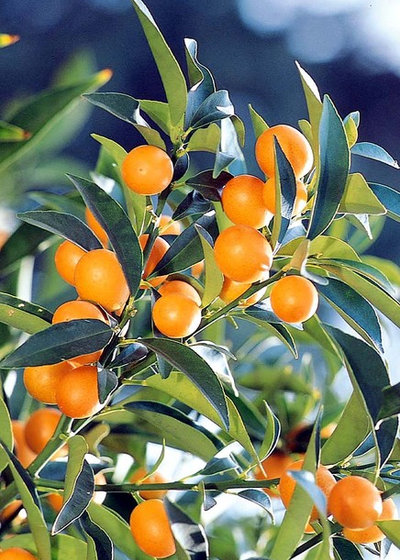
Monrovia
'Nagami' Kumquat Plants with thumb-size fruits like glossy gems start to show color in fall and peak in spring. The bushy, shiny-leafed plants are small enough to live in containers for several years. Move your container plant into a protected spot (or indoors) if winter nights get too chilly.
USDA zones: 9-10 (find your zone)
Water requirement: Moderate, more often in hot climates
Light requirement: Full sun or part shade especially in a container in hottest climates
Mature size: 8 feet tall, 6 feet wide (when grown in the ground)
Growing tips: Good soil mix is a must. Keep foliage shiny green with citrus food; yellow leaves usually indicate lack of iron.
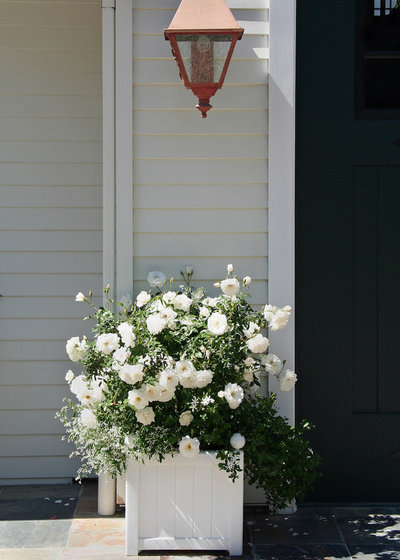
Donna Lynn - Landscape Designer
'Iceberg' and Other RosesIn California and many other mild climates, roses have an autumn bloom that's almost as abundant as spring's. Look around at a nursery in fall and see what roses are blooming nicely.
Container-friendly types tend to be the smaller, more compact Polyanthas, Floribundas, ground cover and shrub roses. 'Iceberg', shown here, is a Floribunda type.
Other good choices for containers include 'Appleblossom Flower Carpet' (pink) 'Caramba' (red), 'Bonica' (pink), 'Carefree Delight' (pink), 'Margo Koster' (orange). If there's room in the container at the base of the rose, plant fall-blooming perennials or annuals, such as pansies or Iceland poppies.
USDA zones: 5-9, depending on species and variety
Water requirement: Moderate. Make sure soil never dries out.
Light requirement: Full sun or light shade
Mature size: Depends on variety. Confinement in container and pruning can limit size.
Growing tips: Choose a container that's big enough to encourage vigorous root growth: at least 12 inches diameter for miniatures and other small types; 14 inches or even a half-barrel size if you want to plant annuals or perennials underneath.
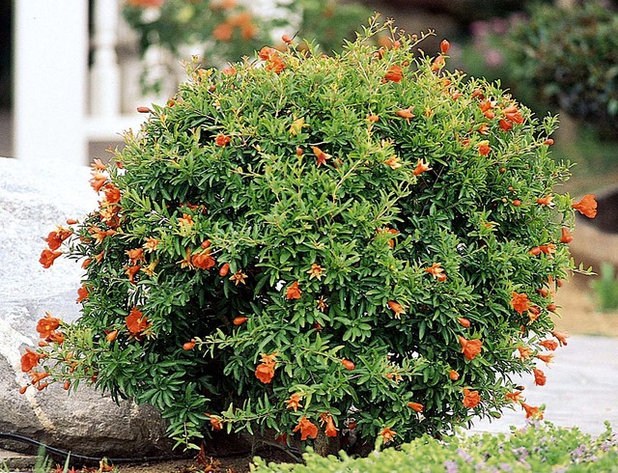
Monrovia
Dwarf Pomegranate First of all, remember that you are not going to harvest market-size red, shiny fruit that weighs as much as a bowling ball — those come from full-size orchard trees tended by growers who really know their stuff. Here we're talking about dwarf pomegranates, such as 'Nana' shown above, that have charms of their own, including waxy bright red flowers for most of the summer, perhaps even followed by tiny miniature fruit-lets, and yellow autumn foliage. A dwarf pomegranate will be content in a container for several years.
USDA zones: 7-10
Water requirement: Moderate
Light requirement: Full sun
Mature size: Dwarf types 2-3 feet tall by 4-5 feet wide
Growing tips: To control size and keep plants bushy, prune in winter when leafless; cut out spindly branches, and cut back long stringy upright branches.
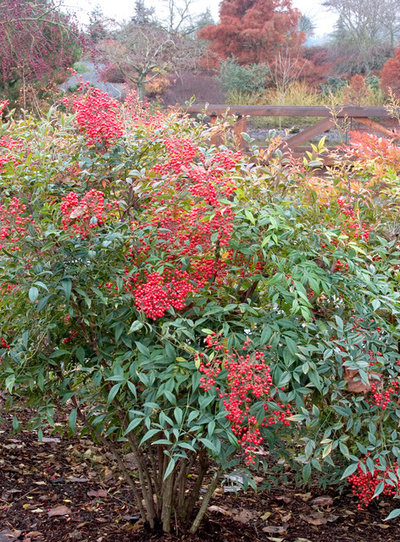
Monrovia
Dwarf Nandina Nandina domestica 'Compacta'
Nandina is such a common landscape plant that it's easy to overlook its natural beauty — imagine what you'd think if you had never before seen its elegant slender branches, reddish fall foliage and berries. Several container-size types of dwarf nandina share those same attributes. Shop carefully, because some of the dwarfs look stumpy.
USDA zone: 6-11
Water requirement: Low to moderate
Light requirement: Full sun or part shade in hot climates
Mature size: Dwarfs 2-4 feet tall, 2-3 feet wide
Growing tips: Prune carefully to reveal the stems; cut off stems near the base. Don't lop off branches near the top, which will force bushy, graceless tops.
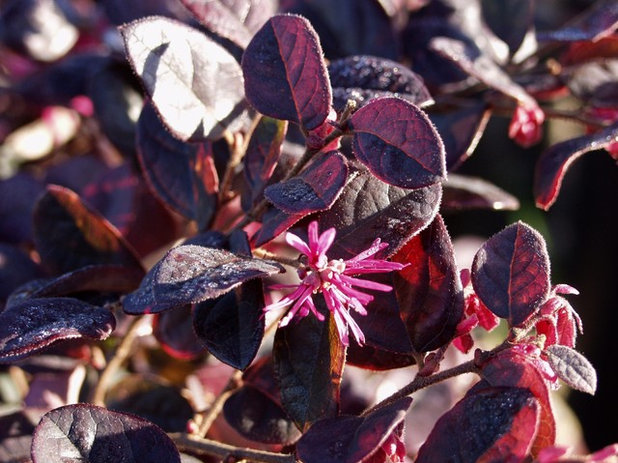
San Marcos Growers
Fringe FlowerLoropetalum chinenseBack in the 20th century, fringe flower was an underappreciated green-leafed, white-flowered shrub usually described as "elegant" or "subtle." But then the plant breeders got hold of it, developed varieties with colorful leaves and flowers, and razzledazzle names like 'Razzleberri', or simply 'Hines Purple Leaf', shown here.
Particularly in California, the purple forms are some of the most widely used landscape plants. They're also great in pots — especially in fall when the purple leaves and pinkish flowers add a jolt of color. Low-spreading forms look best in a pot, where they can stay a few years; then move them into your garden for a landscaping job.
USDA zones: 8-9, can grow in colder climates but is decidous
Water requirement: Moderate
Light requirement: Full sun, part shade in warmer climates, especially for plants in containers
Mature size: 6-10 feet tall, equal spread (pruning keeps it smaller)
Growing tip: Prune to control height; cut back upward branches to encourage spread.
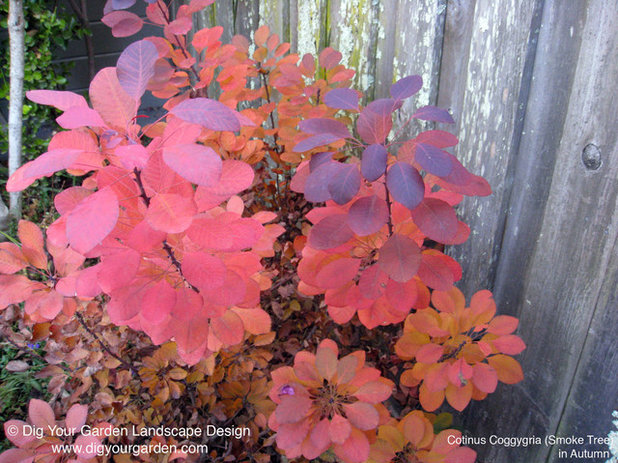
Dig Your Garden Landscape Design
Smoke TreeCotinus coggygriaThis three-season, deciduous shrub — although vigorous and rangy — can give you a year or two in a pot. In fall, treasure its purplish leaves. In spring and summer, the puffy, fading flowers inspire the smoky name. When a plant threatens to outgrow its container, move it into the garden as a background plant.
USDA zone: 4-9
Water requirement: Moderate; do not overwater
Light requirement: Full sun or light shade
Mature size: 10-15 feet tall, 10-15 feet spread
Growing tips: To control fast growth in pot, prune when plant is leafless or pinch back during the growing season.
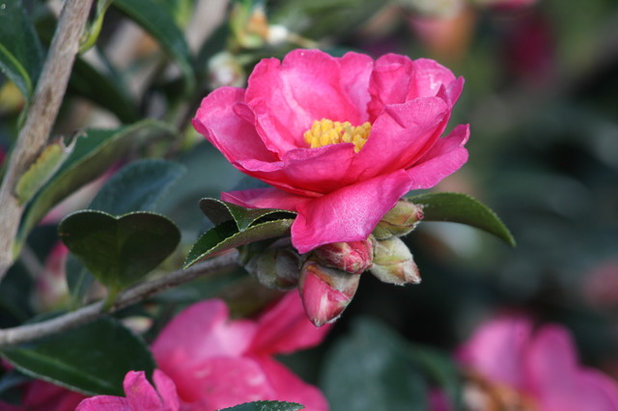
Monrovia
Sasanqua CamelliasThese all-around useful shrubs can also work well in containers. They bloom earlier than the more common
Camellia japonica, from fall through winter, and they're smaller and more varied in size and shape. Choose an upright or spreading type. Colors include white, pink, rose, red. 'Shishi Gashira', shown here, is an old favorite. A fine choice for the holiday season is winter-blooming 'Yuletide', an upright grower with red flowers with yellow centers. Would it look nice near your front door in December?
USDA zone: 7-10
Water requirement: Moderate; do not overwater.
Light requirement: Part shade, especially in hot climates. Will take more sun than common
Camellia japonica.
Mature size: Up to 10 feet tall, 10-15 feet wide (depends greatly on variety)
Growing tips: Camellias are well worth special soil; start with commercial camellia mix or make your own with at least 50 percent organic matter. Pot size is also important: diameter of 12-14 inches for gallon-can size plants, 16-18 inches for 5-gallon size.
More: California Garden Guide





